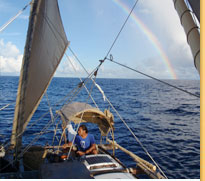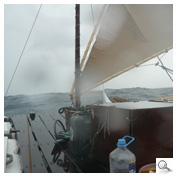The expedition had to face various difficulties, some of which were not predictable at the beginning of the voyage.
According to the Pilot Charts (weather data documented over the last 200 years) we should have encountered mainly light North-West monsoon winds. These winds from astern should have made it a favourable sailing trip. However these monsoon winds often didn’t show up. Instead we encountered local wind systems activated by the huge mountainous islands we passed. Particularly during the second part of the voyage we frequently had headwinds.
During the entire voyage we had to face frequent squalls and heavy rain. One heavy dark cloud after the other; starting with a strong wind followed by heavy rain, then hardly any wind at all. This required continuous vigilance and frequent sail changes day and night.
The rain sometimes continued for many days and there was nothing dry aboard. Even saltwater got into our bunks by waves hitting the hulls and entering the big hatches, which were not entirely watertight.
We also had many frustrating periods of calms and very light winds with unbearable heat, making little progress.
More dramatically we had to sail under the dark ash cloud of an active volcano to reach the bay of Rabaul, PNG.
All anchor manoeuvres had to be done without an engine, which was sometimes difficult in unknown waters under strong wind conditions with reefs and rocks around. Having no engine also meant we frequently had to wait the night out at sea to enter harbour in daylight; no quick run in under engine before nightfall! Charts were unreliable for accurate GPS navigation and most harbours unlit.
A strong storm hit us in the Bismarck-Sea. Though professional photographer Philipp Hympendahl was aboard the ‘Lapita Tikopia’, he couldn’t take any photos as all hands were needed in the severe conditions. With smallest sail and two sea anchors the crew were able to weather the two day gale. In this same storm ‘Lapita Anuta’, due to a navigational error, had to sail 9 Nm close hauled under stormsail in huge beam seas to reach shelter at the agreed rendezvous. Boats and crew came through safe and sound.
There were also some adventures of a different nature; having to pay a bribe to officials in the Philippines in order to receive the documents for leaving the country; spending hours in Indonesian harbour/custom offices and paying more money to continue the voyage.
On the islands of Karkar and Kabacon people stole some items of our equipment.
We carried a large medicine store, even so nearly everyone was handicapped by tropical ulcers due to the hot, humid conditions and bacteria. A small cut could cause a festering sore within days. Sitting on the hard wet decks caused similar sores on bottoms, very painful! One crewmember had a serious tropical skin infection and had to stay ashore for two weeks for daily hospital injections.
Some suffered seasickness, or headaches and exhaustion from the humid heat. One crew suffered heat-stroke and dehydration which led to an infection of the urethra and later of the kidneys and had to be operated on when returned home.
Both skippers, Hanneke Boon and Klaus Hympendahl, lost a lot of weight. James Wharram, aged 80 with a worn knee joint and frozen shoulder, suffered acute and continuous discomfort due to the tight living accommodation; though remarkably healthy throughout the voyage he finally succumbed to a lingering stomach bug and exhaustion, deciding him to return home 200Nm before the end of the 4000Nm voyage, to avoid being a burden on the others. The prospect of a difficult landing in Anuta clinched his decision.
In spite of the difficulties we experienced, the voyage achieved all its objectives.






